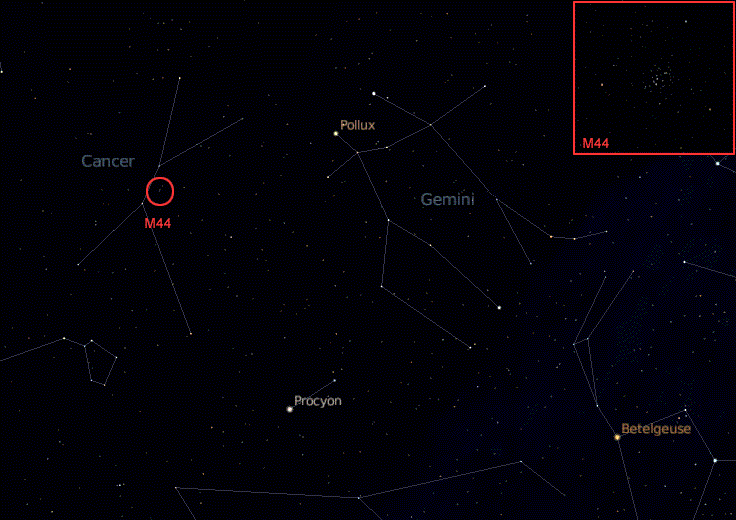
April 2015 - Vol. 19, No. 4
This Month's Night Sky - NOTE: The next paragraph describes the sky as it appears at 10 pm EST (11 pm EDT) near mid- month. The sky also looks this way at 11 pm EST (midnight EDT) during the beginning of the month and at 9 pm EST (10 pm EDT) by month's end.
As the days lengthen, the stars of the Winter Triangle fade into evening's dusk. The "Big Dipper" asterism (Ursa Major) is well placed for viewing this month since it is almost directly overhead. Follow the curve of its handle to Arcturus (Bootes) and continue on the curve to Spica (Virgo). Regulus (Leo) is on the ecliptic (the path traced by the planets and Moon), just W. of overhead. Further W., on the ecliptic, find the Gemini Twins, Castor and Pollux, and finally the Pleiades asterism of Taurus.
MERCURY is at superior conjunction on April 10. VENUS rides high in the evening sky. JUPITER is in the constellation of Cancer. MARS vanishes from the evening sky, not to reappear until early morning in August. SATURN rises before midnight. URANUS reappears in morning sky late in the month. This month's Lunar Eclipse occurs on April 4.
Review how to determine Angular Measurement.
Calendar of Events
NOTE: For those observers not in the ET zone, convert the calendar times to your zone's time by subtracting one hour for CT, two for MT and three for PT. Don't forget to adjust for Daylight Savings Time when necessary by subtracting one hour from your planisphere's time. Dawn and dusk times must also be corrected. See your local newspaper, TV news, or cable TV's Weather Channel for sunrise and sunset times. Unfortunately some of these events may occur during daylight hours in your area.
| DATE | EVENT |
| 01 | Moon at apogee. |
| 03 | Jupiter 5 deg N. of Moon. |
| 04 | Full Moon,a total lunar eclipse is a "short" eclipse with the total phase lasting only 4.5 minutes. The eclipse is centered over the Solomon islands in the Pacific Ocean, and parts of North and South America will miss the early stages of the eclipse. Observers in Europe and Africa will not be able to see any of the eclipse. |
| 08 | Saturn 2 deg S. of Moon. |
| 10 | Mercury in superior conjunction. |
| 12 | Jupiter stationary in Cancer. Saturn 2 deg S. of Moon. |
| 17 | Moon at perigee. |
| 19 | Mercury at perihelion. |
| 21 | Venus 7 deg N. of Moon. Aldebaran .9 deg S. of Moon, this will be an occultation from northwestern USA, Canada, Greenland, Iceland, Scandinavia, and northwestern Russia. |
| 22 | Lyrid meteor peak. Although the shower is generally fairly weak, it sometimes is surprising! |
| 23 | Mercury 1.4 deg N. of Mars. |
| 26 | Jupiter 5 deg N. of Moon. |
| 29 | Moon at apogee. |
Lunar Almanac for April 2015
| Phases of the Moon | Phase and Date(s) | Best viewed before local midnight |
 |
New 18 |
Deep Space Objects |
 |
1st. Qtr 25 |
Planets & Moon |
 |
Full 4 |
Moon |
 |
Last Qtr 12 |
Deep Space & Planets |
Topic of the month: The Hyades, binocular object
The Hyades is an open star cluster in the constellation of Taurus, also called the Beehive Cluster.
The Beehive Cluster is considered to be one of the best best binocular sights of the night sky. Although situated in a lonely place in the sky, it is relatively easily seen by the naked eye, even under the handicap of typical city light pollution. It is found on the ecliptic, the path of the Moon and the planets, in the Constellation Cancer. However, it may require a good planesphere or star chart to find it!
The Beehive Cluster is an example of an "open cluster". Open clusters usually have no definate shape as compared to globular clusters. M44 can be located by finding the Gemini's twin stars and Procyon, the brightest star in Canis Minor. You may recognize Procyon as being the left most star of the "winter triangle". M44 "forms" a triangle with Procyon (below, right) and Pollux, the lower of the Gemini "twins" (above, right).

--See You Under the Stars!
Astra for Astra's Almanac
The star chart above was generated by Stellarium, a free open source planetarium program. This image was created by Dawn Jenkins, using Stellarium and a graphic editing program to highlight M44 and to format the image for this web page. The Mars position represents the position of Mars as April begins. Stellarium offers much to amatuer astronomers and is being used in planetariums. Simple charts like the one above can be used on the internet for non-profit, illustration purposes. Proper credit is due of course! Thank you to the makers of this fine program from Astra's Star Gate.
This installment of "Whats Up?" is ©2015 by Dawn Jenkins for Astra's Stargate. View Ron Leeseburg's Farewell Issue for information on where to find information such as is presented in this almanac.